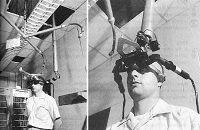Technology Education with Virtual Reality : New Method for Limitless Potentials
January 01, 2019
Edit
Technology Education can come with different kinds of form. For example, the most basic use of technology is the search engines. It’s not a new thing to find new information on the internet. With it, we can learn about something new without giving a lot of efforts to do that. We can learn about so many new things that we didn’t know before, like the world of robots for example.
The technology is cannot be divided from the world of entertainment, for example, the gaming world. Parts of hardware and software grow more advanced these days. The players can get more and more realistic experience through the new method, which is Virtual Reality.
History
Back in 1968, there was a person who responsible for this creation named Ivan Sutherland. He was the father of VR, creating the Sword of Democles, the first VR / Augmented reality that connected the display that mounted on the head and connected with a computer. This revolutionary technology was criticized for being “too scary for humans” because the form of it is not very applicable and indeed to heavy for the users.
But, do you think that the creation by Ivan is actually the first VR ever in this world? Not, it is not. Back to hundred years ago, we can even find the ideas of VR that reflected through mural paintings. In 1838, there are some painters who can create 360-degree mural paintings in order to recreate the exact moment of the particular event that shown through the paintings, giving the viewers a wide field of vision.
So, the use of technology education was first used even in the times that we’re not expected. The VR and AR Technology was growing so fast since the Sword of Democles. Even the game company like Sega was interested in this VR technology and decided to create one product in 1993 with the name of VR Glasses.
After the introducement of VR and AR in a movie (The Matrix) that showed the people how amazing this form of technology education is, many TV companies were started to give more attention to it, especially because of the fact that it can attract so many potential viewers.
After the introducement of VR and AR in a movie (The Matrix) that showed the people how amazing this form of technology education is, many TV companies were started to give more attention to it, especially because of the fact that it can attract so many potential viewers.
That’s why, some companies are trying to be creative by using it as technology education approach to Tv programs, in order to make them more clear, educating, and also realistic.
For example, there's a weather channel that can show directly viewers the condition of current weather and the most importantly the effects of it in some regions of the city.
Applications of VR/AR and Potentials
Aside from that, AR technology education is also be used in some news around the globe. But this time, the technology is used to create a more visual environment that is very eye-catching to the viewers of the news program and make them not switching to another different channel. We can show you the perfect example of this MBC Newsdesk program by MBC News that based in Seoul, South Korea.
Now, this type of technology education can surely bring something positive to our lives. The kids now can even learn more new things realistically by VR and AR technologies. For example, there’s a virtual reality class program that can give students the opportunity to learn and studying something through the whole new method.
While learning, they can surely have some fun by witnessing something new and interesting to them. Sometimes, they can even bring a lough to them. This technology can be applied to all the schools. With the integration of teachers teaching plan, students can see the dynamic interest points while studying.
With the technology education that we’re facing these days, it’s not so hard anymore to gain information and train for better skills with VR and AR without risking anything. But of course, we need to get open-minded in order to be ready for more advanced technology. And now here’s the ultimate question for all of you. Are you ready?



